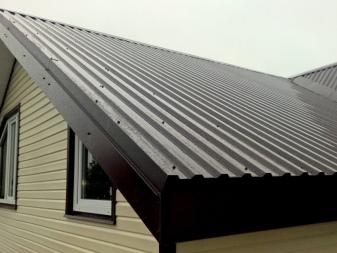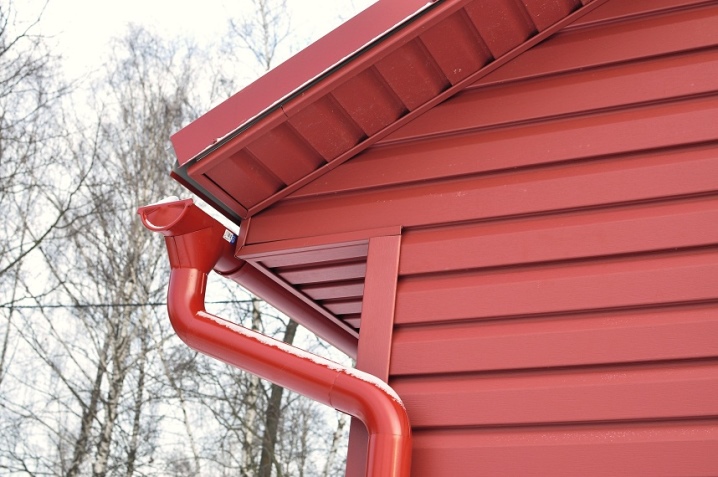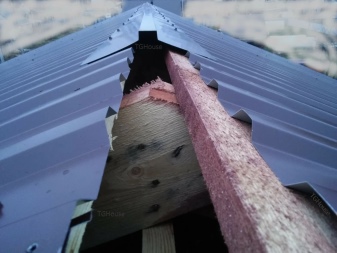All about the curtain rods from the profiled sheet

The cornice is a decorative but functional stucco molding that crowns the building.... Its main function - to divert rainwater from the walls, but at the same time it is distinguished by its decorative design... In residential buildings, this function is performed due to the protrusion of the ends of the pediment, the eaves of the roof and the gutters. Profiled sheet curtain rods used for cladding the space between the wall and the roof are a universal option for using waterproofing elements or gutters.


Norms
Before proceeding directly to the roofing work of the eaves from the profiled sheet, it is worth familiarizing yourself with the basic standards for the size of eaves overhangs. The minimum overhang is 50 centimeters and varies up to 1.5 meters. All recommended lengths are included in the standards SNiP II. II-26-76.
They will depend on a number of factors, including the technical characteristics of the roof structure used. Among other things, acceptable standards may vary and depend on the type and purpose of the building.
However, it is worth noting: there are only recommendations, since there are no strict limits on the horizon.

Certain dimensions differ depending on the coating material:
-
ceramic tiles have a minimum overhang of 70 mm;
-
for slate, the values will be 50 mm;
-
profiled sheet and steel roof - not less than 100 mm.



Device
The device of the corrugated roof cornice has several layers. So, several structural elements go from bottom to top.
- Rafters... Naturally, it is impossible to build a roof without a rafter system, since it is a load-bearing structural system for a pitched roof.
- Dropper... It's not hard to guess from the name that this overhang apron, attached to a gable or cornice, helps to cope with moisture during rain or melted snow.
- Waterproofing... It is used to prevent moisture ingress and is of several types: guided roll, with an adhesive base, or mounted on bitumen mastic. And also there is a liquid waterproofing with a rubber filler, bitumen-polymer or rubber-bitumen.
- Cornice strip. An obligatory additional element for corrugated board, it is used to give a neat look and a long service life to the entire structure.
- Initial crate. Building system for the base. The following components are mainly used here:
-
plywood;
-
grooved or regular boards;
-
timber;
-
tes.
-

- Counter grill... It is used practically without exception for any pitched and gable roofs, it is an element of the roof.
- Profiled roofing systems. Best for slopes greater than 5 degrees. The profile consists of corrugations, each of which has a specific shape, they are superimposed on each other from side to side and end-to-end, which makes it easy to cover different parts of the roof. Profiled sheets are usually made of coated steel, but can also be supplied in aluminum and have mastic seals located in the end and side laps.
Fasteners usually pass through the profile "sump" rather than through the corrugation.
- Lathing and roofing material. First of all, the crate is laid on the rafters, and already based on the system of their construction in the future, it is possible to make an attic or an attic room that is quite suitable for living. When covering the roof, a universal sheet is most often used.When choosing a material for eaves, you should definitely pay attention to the type and height of the corrugation. In the case of a pitched roof of a house, it is best to use a "wave" with a height of 21-35 cm for the roof. And the shape of a "trapezoid" is also ideal. The optimum sheet thickness should be 0.8-1 mm. Additionally, you need to take into account the slope of the slope and the quality of the lathing. However, the most common is precisely the gable roof, and in this case it is necessary to take into account the effect of UV radiation, resistance to weather changes, fire resistance and tightness.



Tools and materials
Installation of the roof is carried out on the crate, located either above the rafters or above the insulation.
For work, in addition to the J-profile and profile sheet, you will also need:
-
in case the house is built of foam block or brick, as well as other similar materials, it is necessary to take a hammer drill and self-tapping screws with rubberized washers;
-
any tool, including metal scissors for cutting;
-
edged board or bar more than 40 mm wide;
-
building level;
-
a ruler with a pencil or other writing object;
-
screwdriver with dowels or wood screws;
-
curved in the shape of the letter "L" strip or square.

For cutting corrugated board you will need:
-
steel corrugated board up to 0.6 mm;
-
small step hacksaw;
-
jigsaw for metal;
-
circular saw with fine teeth.


To equip the lathing:
-
timber 50x50;
-
board 32x100;
-
Chipboard or plywood about 10 millimeters.

How to do it?
For a pitched roof, a minimum slope of 4-5 degrees is recommended. Do-it-yourself filing is used by stacking profile sheets in purlins. To sew properly, start at the eaves and in the corner, away from the direction of the winds. If the first layer is not laid perpendicular to the cornice and the ridge, you need to regularly adjust the work when laying subsequent sheets, and the effect of a "saw tooth" will be observed on the cornice.
The first row should overlap the bottom batten and cornice so that rainwater can drain into the gutter or outside the walls. Each sheet is overlapped by subsequent side laps in the purlin using corrugation or at least one profile.
When erecting with your own hands, it is worth paying attention - the maximum length of the supplied sheet is up to 9 m.If you require a longer length, you will need to perform a run on 2 sheets, as shown in the image above.


For lateral circles. An excellent way is to use a mastic lapping tape and grind screws to ensure a strong and weather-resistant side lap joint. A lapping tape with a 9x1.5 mm section of mastic should be run along the ridge of the profile. The profile, meanwhile, has to be ground in, then screws are used to stitch the sheets at 600 mm intervals down the overlap to secure the joint created by the tape.
For end overlaps, the minimum sheet overlap should be 250 mm, this overlap must be supported from below by a purlin. As with side laps, it is recommended to use lapping tape to create a strong, weather-resistant connection. A strip of tape should be placed across the overlap width approximately 25 mm from the top, overlapping or bottom sheet. Lapping tape is considered the most effective, as opposed to silicone.


Roof protection equipment
It is worth mentioning right away that temperature is equally important in roofing construction. So, in the summer it should not exceed 30 degrees Celsius, and in the autumn-winter months, it should not fall below 15 degrees. Roofing work can be hazardous. Care should be taken and appropriate safety precautions should be taken, including the use of suitable protective gloves, clothing and footwear.
Two workers are capable of lifting one sheet from the truck at the same time, depending on physical capabilities and weather conditions. It will also depend on the length of the sheet and the weight.The weight of the sheets is indicated on the website. Take extra care in windy or open areas.
The edges of the sheets and edging can be sharp, so be sure to wear protective gloves with rubber palms for grip.

Do-it-yourself installation of the cornice is shown in the following video.













The comment was sent successfully.